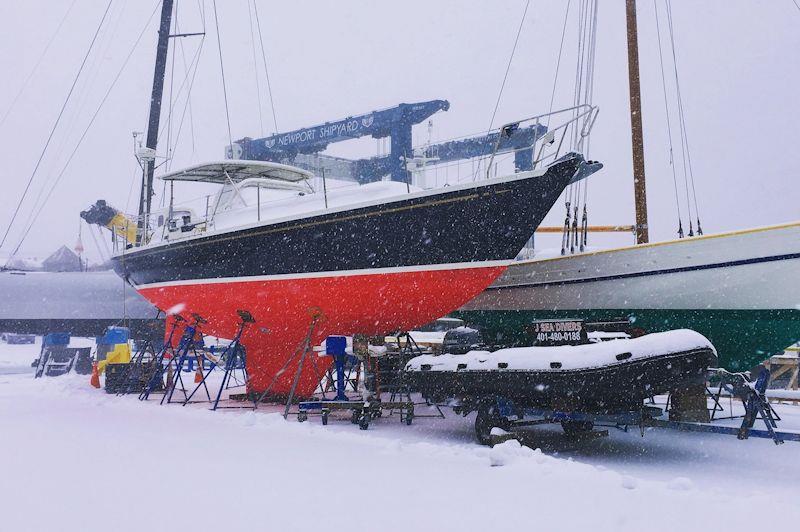
Top Five Tips To Get Your Boat Winter Ready by Upffront.com
by Johnny Appmann 8 Dec 2022 09:00 UTC

Get Your Boat Winter Ready © Newport Shipyard
As its that time of the year again when most of us have to pack up our sails and move the boat into storage - if you haven't done so already. Winterizing your boat is a thorough process that can lead to serious damages when not done correctly.
From taking out the mast, to making sure your sails, engine and batteries all survive the winter storage there are quite a few things to be considered. We've put together some handy information for you, to make sure it all goes smoothly.
Generally speaking there are five key categories to consider.
1. Sails
The first and most obvious part of getting your boat ready for winter storage is taking care of the sails. You should make sure to take them entirely off the boat and store them in a dry safe place, protected from moisture, weather and rodents.
If you're not giving your sails to a loft for some checking, there a few points to consider. Firstly, inspect the attachment points and check the edges - leech, luff, and foot of the sail. Check for damages such as chafe and tears and evaluate how much life is left in the cloth. Sailmakers usually offer discounts at the beginning of the winter so it may be worth getting a quote early in case some sails need repairing/ replacing.
Taking the sails off your boat also gives you a great opportunity to give them a bit of a clean - nothing excessive, just a light spray with fresh water, a brushing off and then dry thoroughly.
2. Cleaning
Further to cleaning your sails, having your boat on the hard gives you the perfect opportunity to do a full clean of the inside as well as the hull. Organising all the equipment and spares you have on board, and maybe chucking out some stuff that accumulated over the season, will put you on track for any winter jobs you will have on your to do list and a tidy boat makes for a much better platform to work on!
Furthermore, taking off any additional supplies protects them from weather damage or even theft. Working on the hull is much easier with your boat being on land, so after pressure washing the hull, rudder and prop you can inspect these for any damages and areas that may need some winter TLC.
Once you've done all the cleaning, if your boat stays outside for the winter make sure to cover it! Anything will do, a simple tarp for example. The key is here to give your boat some protection from the elements.
3. Draining Water out of the system
Especially if your boat is in areas that drop to temperatures below freezing it is essential that you get rid of any water in any systems. You do not want pipes to freeze or even burst so make sure to get all the water out. As you don't want all systems to run dry over the winter, however, make sure to replace it with marine grade, non-toxic antifreeze.
This will be safe for any water containing system on your boat and they are also generally biodegradable, so do not harm the environment either. This way you can make sure that the plastics and seals won't deteriorate over the winter and you can relaunch your boat without any leaks.
4. Engine
Another part of your boat which you should prepare for winter and next season, is the engine. Make sure to drain the water from it as well and replace with antifreeze. Also drain your seacocks, so that your engine won't crack due to water freezing in it - which can be a costly mistake. All the dirty oil that you've used throughout the season should be replaced, potentially the oil filter as well. This will prevent corrosion from any contaminated oil just sitting there.
Similarly, the fuel tanks should be filled up for the winter. A half empty tank leaves room for condensation which in turn can lead to corrosion, whilst a half-filled diesel tank gives algae opportunities to grow. These issues can be addressed by adding fuel stabilisers, or in the case of diesel, biocide.
5. Batteries
Last but not least, make sure your batteries are fully charged and disconnected from any sources that may draw power. If you're unsure about leaving them on board you can take them home and connect them to a battery tender to keep them charged for next season.
So just to recap:
- Take your sails off and evaluate them - if they need replacing contact a loft early otherwise store them somewhere well protected.
- Give your boat a good clean both inside and outside, take this as an opportunity to organise all the equipment and supplies on board.
- Identify what areas you need to work on over the winter so you can get your to-do list ready.
- Any water should be drained from the system and replaced with antifreeze
- For your engine replace oil and filter and top up the tanks. You can also add fuel stabilisers or biocide.
- Charge your batteries and make sure there's no more power drawing off them.
- Finally, cover your boat to have it protected from the weather and start planning your next season!
If you have any questions about winterising your boat or any other sailing hardware and rigging questions, do not hesitate to contact us at .
One final, parting Tip: Do not leave everything to the spring - buy any replacements and spare parts at the end of the season rather than the beginning of the next, to get the best prices! Browse all our products on the link below.
